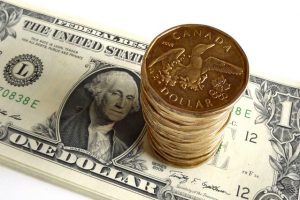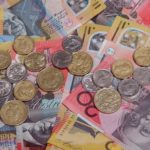 Yesterday’s trade (in GMT terms) saw USD/CAD within the range of 1.3101-1.3194. The pair closed at 1.3156, edging down 0.25% compared to Wednesdays close. It has been the 139th drop in the past 304 trading days. The daily low has been the lowest level since July 22nd, when a low of 1.3056 was registered. The major pair has pared its advance to 1.80% so far during the current month, following a 1.29% slump in June.
Yesterday’s trade (in GMT terms) saw USD/CAD within the range of 1.3101-1.3194. The pair closed at 1.3156, edging down 0.25% compared to Wednesdays close. It has been the 139th drop in the past 304 trading days. The daily low has been the lowest level since July 22nd, when a low of 1.3056 was registered. The major pair has pared its advance to 1.80% so far during the current month, following a 1.29% slump in June.
At 7:39 GMT today USD/CAD was inching up 0.02% on the day to trade at 1.3159. The pair touched a daily high at 1.3177 during late Asian trade, overshooting the daily R2 level, and a daily low at 1.3132 during the mid phase of the Asian trading session.
Meanwhile, crude oil futures marked their 88th drop out of the past 159 trading days on July 28th. Oil for September delivery went down as low as $41.04 per barrel, or a level unseen since April 20th, and closed at $41.14, losing 1.86% compared to Wednesday’s close. As of 7:49 GMT today the commodity was shedding 0.63% to trade at $40.88, after going down as low as $40.83 per barrel earlier. Crude oil prices and CAD valuation tend to be strongly positively correlated.
On Friday USD/CAD trading may be influenced by the following macroeconomic reports as listed below.
Fundamentals
United States
Gross Domestic Product – preliminary estimate
The preliminary estimate of the US Gross Domestic Product probably pointed to an annualized rate of growth of 2.6% in the second quarter of the year, according to market expectations. If so, this would be the fastest annual rate of growth since the second quarter of 2015, when US economy grew at a final 3.9%. The final GDP estimate for Q1, reported on June 28th, pointed to an annual growth of 1.1%, a revision up compared to the second GDP estimate.
Consumer spending in the country rose 1.5% year-on-year in the first quarter of 2016, decelerating from a 1.9% surge in the second estimate, and following a 2.4% expansion in the fourth quarter of 2015. The Q1 rate of growth has been the slowest one since the first quarter of 2014.
Fixed investment shrank at a final 0.4% year-on-year in Q1, improving from a 1.5% contraction in the second estimate, as non-residential investment contracted 4.5% and residential investment rose 15.6%. Fixed investment was 0.4% higher in Q4 2015 compared to the same period a year ago.
US exports grew at an annualized rate of 0.3% in Q1, following a 2.0% contraction in the second estimate, while shrinking 2.0% in Q4 2015. At the same time, US imports shrank at a final 0.5% year-on-year in the first quarter of 2016, accelerating from a 0.2% decrease in the second estimate and following a 0.7% decline in the fourth quarter of 2015, according to data by the US Department of Commerce.
In case the preliminary GDP estimate met or even outpaced expectations, this would certainly boost the US Dollar. The preliminary data is due out at 12:30 GMT.
Meanwhile, the Employment Cost Index (ECI) for the United States probably rose 0.6% during the second quarter of the year compared to Q1, following another 0.6% gain in Q1 compared to Q4 2015. This index measures the change in the price of labor, defined as compensation per employee hour worked. It shows changes in the cost of compensation not only for wages and salaries, but also for an extensive list of benefits. The ECI is considered as an indicator, reflecting cost pressures within companies that could trigger price inflation for finished goods and services. A larger than expected rate of increase would generally support demand for the US dollar. The Bureau of Labour Statistics is to release the quarterly data at 12:30 GMT.
Reuters/Michigan Consumer Sentiment Index
The monthly survey by Thomson Reuters and the University of Michigan may show that consumer confidence in the United States was lower in July from a month ago. The final reading of the corresponding index, which usually comes out two weeks after the preliminary data, probably came in at 90.5, up from a preliminary value of 89.5. In June the index stood at a final reading of 93.5, down from a preliminary value of 94.3. The survey encompasses about 500 respondents throughout the country. The index is comprised by two major components, a gauge of current conditions and a gauge of expectations. The current conditions index is based on the answers to two standard questions, while the index of expectations is based on three standard questions. All five questions have an equal weight in determining the value of the overall index.
According to preliminary data, the sub-index of current economic conditions, which measures US consumers’ views of their personal finances, went down to 108.7 in July from a final reading of 110.8 in June. The sub-index of consumer expectations decelerated to a flash reading of 77.1 in July from a final value of 82.4 in June.
Respondents in the July survey expect that the rate of inflation during the next year will probably be at 2.8%, up from 2.4% as expected in the June survey.
In case the final value of the July consumer sentiment index outpaced the median forecast by analysts, this would have a moderate bullish effect on the US dollar. The final reading is due out at 14:00 GMT.
Fed Speakers
At 13:30 GMT the Fed President for San Francisco and also a FOMC member, John Williams, is expected to take a statement, followed by the Fed President for Dallas and also a member of the Committee, Robert Kaplan, at 17:00 GMT. Any remarks on macroeconomic outlook or the Banks monetary policy stance would certainly boost USD volatility.
Canada
Gross Domestic Product
Canadian real Gross Domestic Product (GDP) probably shrank 0.4% in May compared to a month ago, according to the median forecast by experts. If so, this would be the largest monthly contraction since September 2015, when the GDP decreased 0.5%. In April Canadas GDP was reported to have increased 0.1%.
In April, manufacturing production expanded 0.4%, following two straight months of decline, production in utilities rose 1.9%, public sector grew 0.2%, wholesale and retail trade grew 0.2%, while finance and insurance expanded 0.3%. On the other hand, Canadas GDP growth was largely offset by a 7.3% contraction in non-conventional oil extraction, according to the report by Statistics Canada.
In case the monthly GDP met expectations or shrank even more in May, this would have a moderate-to-strong bearish effect on the Canadian Dollar. The official report is due out at 12:30 GMT.
Industrial Product Price Index
Prices of industrial products in Canada probably increased at a monthly rate of 0.5% in June, according to market expectations. In May prices were up 1.1%, rebounding after a three-month string of declines. It has been the fastest monthly rate of increase since February 2015, supported by higher prices for energy and petroleum products (up 6.3% month-over-month), primary non-ferrous metal products (up 1.6%), motorized and recreational vehicles (up 0.7%), chemicals and chemical products (up 1.3%) and fruit, vegetables, feed and other food products (up 0.6%).
This index measures the change in prices of industrial goods, sold by manufacturers in the country. It is also used as an indicator of commodity inflation. In case a larger-than-anticipated increase in prices is reported, this would have a limited bullish effect on the local dollar, as the latter tends to be sensitive to changes in commodity prices. Statistics Canada is to release the official data at 12:30 GMT.
Bond Yield Spread
The yield on Canada’s 2-year government bonds went as high as 0.593% on July 28th, after which it closed at 0.586% to add 0.008 percentage point compared to July 27th.
Meanwhile, the yield on US 2-year government bonds climbed as high as 0.738% on July 28th, after which it fell to 0.707% at the close to lose 1.5 basis points (0.015 percentage point) compared to July 27th.
The spread between 2-year US and 2-year Canadian bond yields, which reflects the flow of funds in a short term, narrowed to 0.121% on July 28th from 0.144% on July 27th. The July 28th yield spread has been the lowest one since July 21st, when the difference was 0.115%.
Daily, Weekly and Monthly Pivot Levels
By employing the Camarilla calculation method, the daily levels of importance for USD/CAD are presented as follows:
R1 – 1.3165
R2 – 1.3173
R3 (Range Resistance – Sell) – 1.3182
R4 (Long Breakout) – 1.3207
R5 (Breakout Target 1) – 1.3237
R6 (Breakout Target 2) – 1.3249
S1 – 1.3147
S2 – 1.3139
S3 (Range Support – Buy) – 1.3130
S4 (Short Breakout) – 1.3105
S5 (Breakout Target 1) – 1.3075
S6 (Breakout Target 2) – 1.3063
By using the traditional method of calculation, the weekly levels of importance for USD/CAD are presented as follows:
Central Pivot Point – 1.3078
R1 – 1.3234
R2 – 1.3341
R3 – 1.3497
R4 – 1.3652
S1 – 1.2971
S2 – 1.2815
S3 – 1.2708
S4 – 1.2600
In monthly terms, for USD/CAD we have the following pivots:
Central Pivot Point – 1.2907
R1 – 1.3163
R2 – 1.3401
R3 – 1.3657
R4 – 1.3913
S1 – 1.2669
S2 – 1.2413
S3 – 1.2175
S4 – 1.1937





